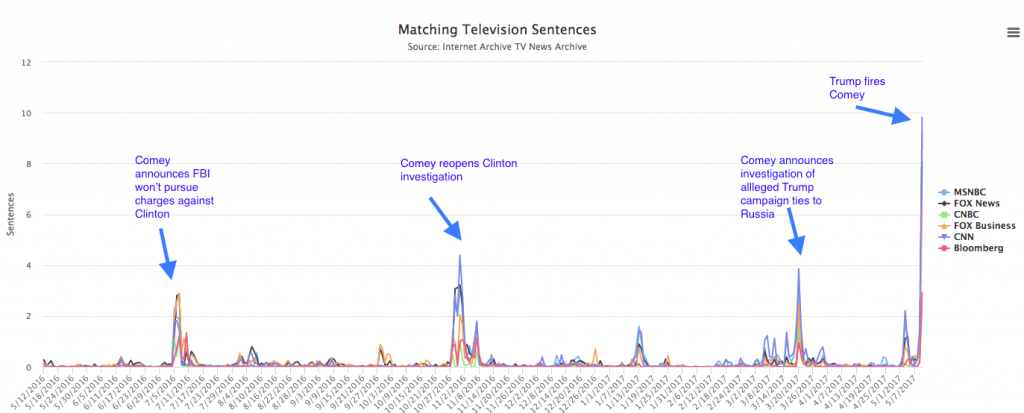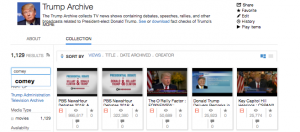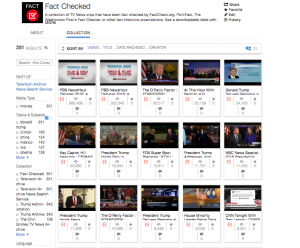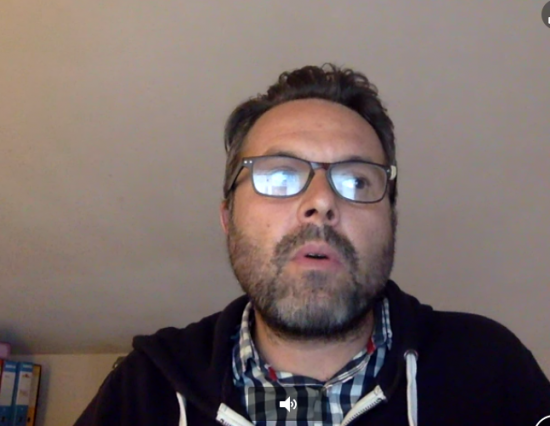We devote this week’s edition of the TV News Archive roundup to the controversy that’s erupted surrounding President Donald Trump’s sudden announcement on Tuesday, May 9, that he was firing FBI director James Comey. The TV News Archive provides a wealth of material for exploring media coverage of this major moment in U.S. history.
Comey fame tied to Clinton and Trump
Comey may still not quite be a household name, but mention of “Comey” spiked higher than ever on TV newscasts this week after he was fired. Comey has enjoyed notoriety in the past, his biggest moments tied closely to the fates of 2016 presidential rivals Hillary Clinton and Trump.
The most recent spike before this week was on March 20, when he testified before Congress, confirming that the FBI was investigating possible ties between the Trump campaign and Russia. Another major spike occurred in November 2016, days before the election, when Comey announced the FBI was reopening an investigation into then-Democratic candidate Hillary Clinton’s use of a private email server for official business while serving as secretary of state. Comey also garnered attention in July 2016, when he announced that the FBI would not be pursuing charges against Clinton.
The visual below, showing mentions of “Comey,” was created with Television Explorer, an online tool fueled by TV News Archive data and created by Kalev Leetaru. This tool can be used to find patterns in words and phrases captured by closed captioning and contained in the TV News Archive.
Trump’s letter to Comey fact-checked
In the hours following the firing, one major point of focus for fact-checkers and other media was the portion of the letter to Comey where Trump stated, “While I greatly appreciate you informing me, on three separate occasions, that I am not under investigation, I nevertheless concur with the judgment of the Department of Justice that you are not able to effectively lead the Bureau.”
Below is a CNN broadcast, as captured in the TV News Archive, where the CNN newscaster Dave Briggs reads the letter on the air.
PolitiFact, The Washington Post‘s Fact Checker, and FactCheck.org have all weighed in on the president’s assertion, noting that too much remains unknown to confirm it. “With Comey out, it’s unclear whether the public will ever learn if the FBI was investigating Trump personally, rather than just his associates — or anything else about the investigation, for that matter,” wrote PolitiFact’s Lauren Carroll on May 11. (See fact-checks connected to televised statements by public officials here.)
Meanwhile, the story continues to unfold. On May 11, Sarah Huckabee, deputy White House press secretary, told ABC’s George Stephanopoulos that the president had confirmed this assertion with her directly. And Trump himself told NBC News’ Lester Holt that the assurances came during a private dinner and twice over the phone. And on Friday morning, Trump tweeted that Comey “better hope there are no ‘tapes’ of our conversations before he starts leaking to the press!”
Some Watergate history, please
Many commentators this week have noted parallels between Trump’s firing of Comey and the Saturday Night Massacre of 1973, when President Richard Nixon ordered independent special prosecutor Archibald Cox fired, during the Watergate investigation; his boss, Attorney General Elliot Richardson, and Deputy General William Ruckelshaus, both of whom refused to fire Cox, resigned in protest. Acting head of the Department of Justice, Robert Bork, carried out the order to fire Cox. (Note: the Richard Nixon Library playfully, but accurately, fired off a tweet noting that Nixon had never fired an FBI director, and then later was criticized for doing so by the National Archives and Records Administration, the federal agency that administers presidential libraries.)
While the TV News Archive’s collection of 1.3 million TV news shows dates back to 2009, long after the Nixon era, some footage from that time is available from later airings. Here, for example, is footage of Cox’s press conference right before he was dismissed.
And here is a quick explainer of the Saturday Night Massacre, as broadcast by MSNBC in 2013.
Searching Trump Archive for past Trump statements about Comey
The largely hand-curated Trump Archive, a collection of Trump statements and appearances on TV news broadcasts, makes it easier to find past instances of Trump talking about Comey. The TV News Archive is working on ways to make the creation of such collections less labor intensive, by using machine learning tools to identify instances of public officials speaking within the collection of 1.3 million tv news shows.
A search of closed captions on the terms “Trump” and “Comey” would yield both instances when Trump is speaking about Comey and newscasters who are reporting on the two men. But searching within the Trump Archive quickly yields Trump statements about Comey.
Here is some of what we found:
April 28, 2016: Trump says “I think if [Comey’s] straight up she’s not going to be able to run.”
June 13, 2016: Trump talking about FBI investigation of Orlando nightclub shooting, “I’m a big fan of the FBI, there’s no bigger fan than me, but look they’ve seen better days. Let’s face it.”
October 13, 2016: Trump speaking about Comey, “The great men and women who work for the FBI are embarrassed and ashamed of what he has done to one of our truly great institutions, the FBI itself.”
October 20, 2016: Trump at Al Smith Dinner, joking at an annual fundraiser for Catholic charities: “I’d like to address an important religious matter, the issue of going to confession. Or, as Hillary calls it, the Fourth of July weekend with FBI director Comey.”
October 29, 2016: Following Director Comey’s letter to congressional leaders about newly discovered Clinton emails, Trump says, “I have to tell you, I respect the fact that Director Comey was able to come back after what he did. I respect that very much.”
November 14, 2016: Trump won’t say if he will ask Comey to resign. “I think that I would rather not comment on that yet. I don’t– I haven’t made up my mind. I respect him a lot. I respect the FBI a lot.”
To receive the TV News Archive’s email newsletter, subscribe here.






